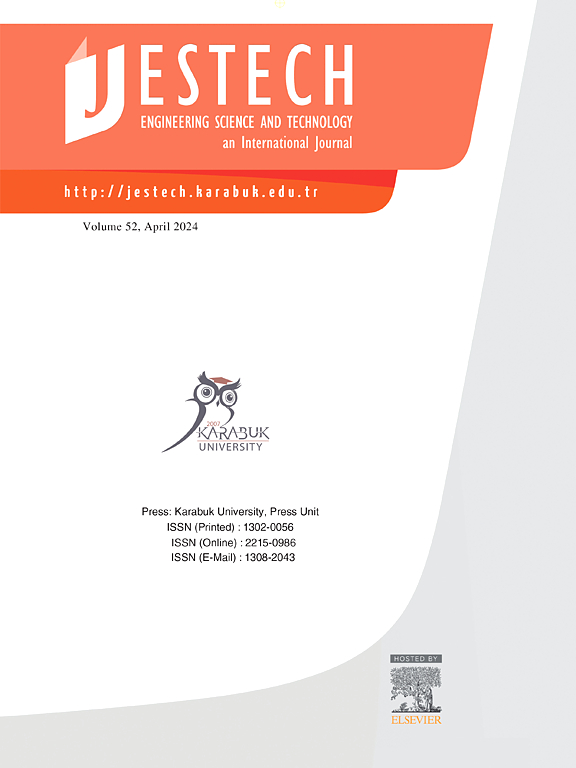将 BIM 与模块化楼板施工决策相结合,对传统现浇楼板施工进行可持续性评估
IF 5.1
2区 工程技术
Q1 ENGINEERING, MULTIDISCIPLINARY
Engineering Science and Technology-An International Journal-Jestech
Pub Date : 2024-11-14
DOI:10.1016/j.jestch.2024.101891
引用次数: 0
摘要
模块化建筑是一种新兴技术,其模块化程度各不相同。在规划阶段对其可持续性表现进行评估,对于决定采用预制构件还是传统的现浇方法至关重要。为此,本研究开发了一个综合可持续发展评估框架,将经济、环境和社会指标融为一体。共从文献中提取了 26 项指标,并由 55 位专家进行了优先排序。因此,有 10 项指标被指定为关键指标,并针对使用现浇(CIS)、工字梁(PIS)和空心(PHS)三种楼板替代方案的三层楼建筑进行了量化。通过多标准决策方法(即 TOPSIS),将 BIM 分析和十项可持续性标准的定性数据配置到决策矩阵中。通过改变可持续发展领域的权重(0.33 - 0.80)对矩阵进行模拟,以确定最佳替代方案的优先次序。BIM 分析显示了 PIS 的显著优势,包括与 CIS 相比,材料和人工成本分别降低了 33% 和 31%。此外,预制构件的碳排放量减少了 60%,损耗减少了 95%,空气污染减少了 90%。TOPSIS 模拟得出的结论是,在所有领域和权重情况下,PIS 系统都具有最高的相对接近系数 (RCC),是最具可持续性的替代方案。PIS 系统在环境领域的表现最佳,其相对接近系数为 0.83 - 0.97,然后是经济领域的 0.83 - 0.86,以及社会领域的 0.69 - 0.83。本文章由计算机程序翻译,如有差异,请以英文原文为准。
Sustainability assessment integrating BIM and decision-making for modular slab construction against conventional cast-in-situ
Modular construction is an emerging technique being adopted with varying levels of modularization. Assessing its sustainability performance during the planning phase is essential for deciding between precast elements and traditional cast-in-situ methods. To address this, this study developed a comprehensive sustainability assessment framework that integrates economic, environmental, and social indicators. A total of 26 indicators were extracted from the literature and prioritized by 55 experts. Thus, ten indicators were designated critical and quantified for the case of a three-story building using three slab alternatives: cast-in-situ (CIS), I-girder (PIS), and hollow core (PHS). BIM analyses and qualitative data for the ten sustainability criteria were configured into a decision matrix through a multicriteria decision-making approach, i.e., TOPSIS. Simulations were conducted on the matrix by varying the weights of sustainability domains (0.33 – 0.80) to prioritize the best alternative. The BIM analyses revealed significant advantages of PIS, including a 33% and 31% reduction in material and labor costs, respectively, compared to the CIS. Furthermore, precast elements show a 60% reduction in carbon emissions, a 95% decrease in wastage, and an additional benefit of 90% less air pollution. The TOPSIS simulations concluded the PIS system as the most sustainable alternative with the highest relative closeness coefficients (RCC) in all domains and weight cases. The PIS performed best in the environmental with RCCs of 0.83 – 0.97, then in the economic with 0.83 – 0.86, and with 0.69 – 0.83 in the social domain.
求助全文
通过发布文献求助,成功后即可免费获取论文全文。
去求助
来源期刊

Engineering Science and Technology-An International Journal-Jestech
Materials Science-Electronic, Optical and Magnetic Materials
CiteScore
11.20
自引率
3.50%
发文量
153
审稿时长
22 days
期刊介绍:
Engineering Science and Technology, an International Journal (JESTECH) (formerly Technology), a peer-reviewed quarterly engineering journal, publishes both theoretical and experimental high quality papers of permanent interest, not previously published in journals, in the field of engineering and applied science which aims to promote the theory and practice of technology and engineering. In addition to peer-reviewed original research papers, the Editorial Board welcomes original research reports, state-of-the-art reviews and communications in the broadly defined field of engineering science and technology.
The scope of JESTECH includes a wide spectrum of subjects including:
-Electrical/Electronics and Computer Engineering (Biomedical Engineering and Instrumentation; Coding, Cryptography, and Information Protection; Communications, Networks, Mobile Computing and Distributed Systems; Compilers and Operating Systems; Computer Architecture, Parallel Processing, and Dependability; Computer Vision and Robotics; Control Theory; Electromagnetic Waves, Microwave Techniques and Antennas; Embedded Systems; Integrated Circuits, VLSI Design, Testing, and CAD; Microelectromechanical Systems; Microelectronics, and Electronic Devices and Circuits; Power, Energy and Energy Conversion Systems; Signal, Image, and Speech Processing)
-Mechanical and Civil Engineering (Automotive Technologies; Biomechanics; Construction Materials; Design and Manufacturing; Dynamics and Control; Energy Generation, Utilization, Conversion, and Storage; Fluid Mechanics and Hydraulics; Heat and Mass Transfer; Micro-Nano Sciences; Renewable and Sustainable Energy Technologies; Robotics and Mechatronics; Solid Mechanics and Structure; Thermal Sciences)
-Metallurgical and Materials Engineering (Advanced Materials Science; Biomaterials; Ceramic and Inorgnanic Materials; Electronic-Magnetic Materials; Energy and Environment; Materials Characterizastion; Metallurgy; Polymers and Nanocomposites)
 求助内容:
求助内容: 应助结果提醒方式:
应助结果提醒方式:


